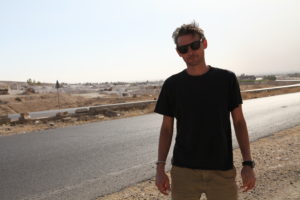Sam Christie
https://soundcloud.com/miranda-whall/sam-christie
Sam is a filmmaker who made his way to film through his work as a sound designer and radio producer. To date he has produced two feature documentaries and many shorter works. He is currently in postproduction on his documentary Carlisle 51 due to be released in the summer 2018. In 2016 Sam spent three months in Iraqi Kurdistan making a feature documentary. This is still in post-production.
As a musician Sam has generally concentrated on jazz. He has drummed for many acts, working as a session player. Most notably he played in The Red Elastic Band with Michael Head, recording the seminal EP Artorius Revisited .
Sam is looking to uncover, in sound and image, the essence of things, perhaps a filmic evocation of truth. His interest in the phenomenological reduction – a return to what things are, free of mythology – is a central focus of his work. In many cases this search leads him to journeys that invite improvisation and encounter. Conscious of the cinema’s power, in mediation and influence, he embraces some of the more complex ethical and methodological questions traditionally posed in the documentary genre.
Sam prefers to frame his work by rules, rules that might guide (or become) the narrative. Framing in this way deliberately problematizes the notion of framing per se. He has found that in doing this he can approach the process of filmmaking performatively.
Currently Sam teaches media production and narrative theory at Southampton Solent University.
http://www.imageandnarrative.be/index.php/imagenarrative/article/view/826
I asked Sam:
What aspect of the landscape inspired your composition
How did you approach writing the composition
How did you approach playing the composition
How did you approach recording the composition
What technical, structural, formal aspects of the composition are specifically interesting
He replied:
What is particularly interesting about this area is the industrial nature of it. That is to say, while at first glance these places might seem wild and untouched, there is evidence of the human hand at every turn. This is probably what is so interesting about the project as a whole for me; even the livestock are essentially alien in this place. I focussed my playing on the human made objects in the environment such as gates and posts, wire and laid stone walls.
I knew from the outset that I wanted to play the objects in situ. I like to be in a place to create things. I think it helps me to feel the weather, experience the terrain and to be immersed visually in a place. I hit things when I play music, so practically I needed sonically viable objects to hit as well.
I do a lot of field recording so I used my standard travel light recorder and a well ‘Rycoted’ shotgun mic. Standard fare. I also used my iPhone to provide me with a click track to gauge tempo. To reflect the complexity of the place I decided to use the time signature of 5/4 at 151bpm.
These are field recordings which have minimal quantities of post production applied, but naturally there are some touches in post. The complexity of the time signature, the tempo and the playing itself is designed to mimic the microcosm that can be found in this landscape. It is, of course, both big and small and I wanted to be able to reflect this sonically.
